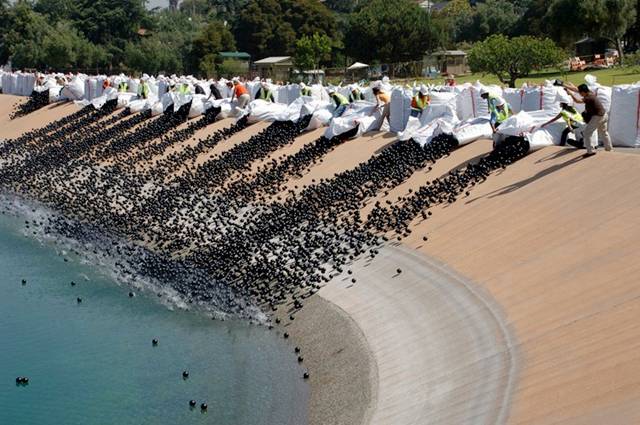Dropping the Balls
Bromide is a naturally-occurring chemical compound found in some groundwater. It’s safe to drink.
Chlorine, in small amounts in your drinking water, is also safe. It doesn’t occur naturally in groundwater, but it is often added to the water supply to control for potentially harmful bacteria.
And sunlight? Also good.
Unfortunately, the three don’t mix all that well. The combination of bromide and chlorine when activated by sunlight results in something called bromate, a compound suspected to be a carcinogen. Having a large-enough amount of bromate in the drinking water is a very big problem, and, if you live in the Los Angeles area, potentially a real one. In late 2007, two reservoirs serving the area were found to be contaminated with bromate. One, the Silver Lake reservoir, was taken out of use completely. The other, the neighboring Ivanhoe reservoir, wasn’t entirely abandoned. Instead, in March of 2008, officials drained the reservoir, refilling it two months later.
They felt comfortable doing so because they believed they had a solution — a way to block the sun.
With 400,000 black balls.

The balls, seen above (via this photo gallery you really should check out), were originally designed to keep birds off the tarmac at airports — the balls were placed in areas where water would collect, making those areas less friendly to wading birds. They are made of high-density polyethylene (HDPE), which is one of the most common forms of plastic (and is free from Bisphenol A). They are black in order to best deflect ultraviolet light and as one nearby resident told the Los Angeles Times, therefore makes it look like the reservoir was overcome by an oil spill. The balls are hollow and therefore float on the water’s surface.
But best of all, the balls are cheap. They cost about 40 cents apiece, making the Ivanhoe reservoir covering run less than $200,000 — pretty good for a public works project. Even the deployment methods were very low-tech — a few dozen workers, outfitted with large white nylon bags filled with just over 2,000 of the balls, poured them into the water, as seen below (via the same gallery).

As TreeHugger.com reported, the Los Angeles Department of Water & Power — the institution charged with operating and protecting the reservoirs — ordered a total of 6.5 million of the balls, with 3 million destined for Ivanhoe and a neighboring reservoir. The long-term plan is to build a permanent cover for Ivanhoe and other reservoirs, but for the short-term, the reservoir doubles as a huge ball pit. (But unfortunately, you can’t jump in.)
Bonus Fact: The world’s actual largest ball pit? It was a temporary one at a Shanghai hotel, part of a stunt to raise awareness around breast cancer prevention. The Kerry Hotel, as seen here, filled its swimming pool with a million green and pink balls, and then opened it to 300 hotel guests who were recovering cancer patients, among others.
From the Archives: Let There Be Light: A way to unblock the sun.
Related: Ball pit balls.
